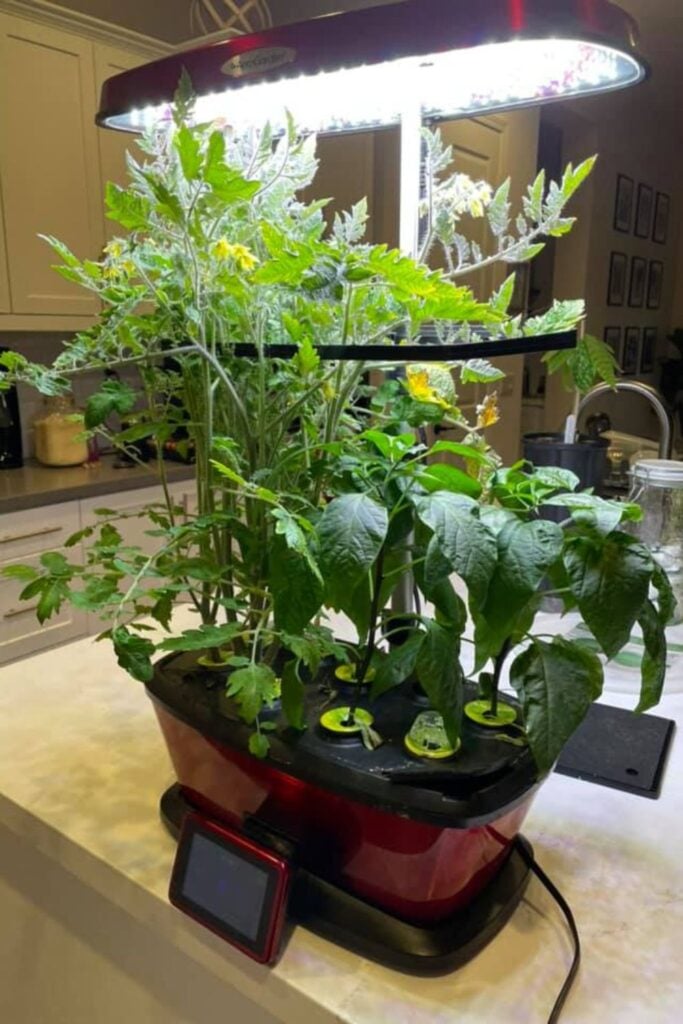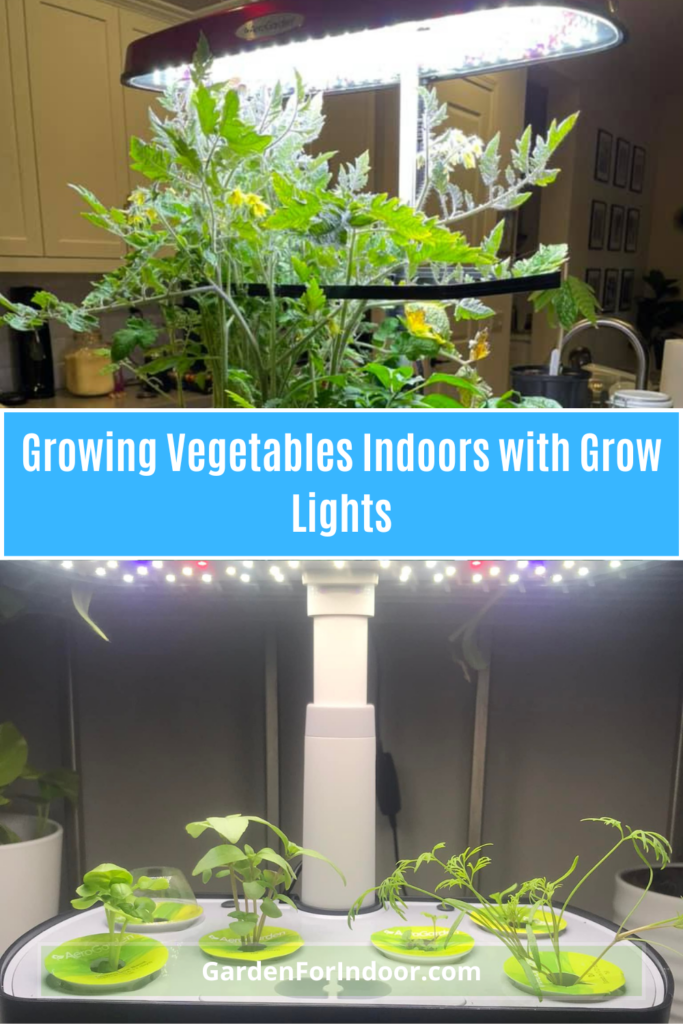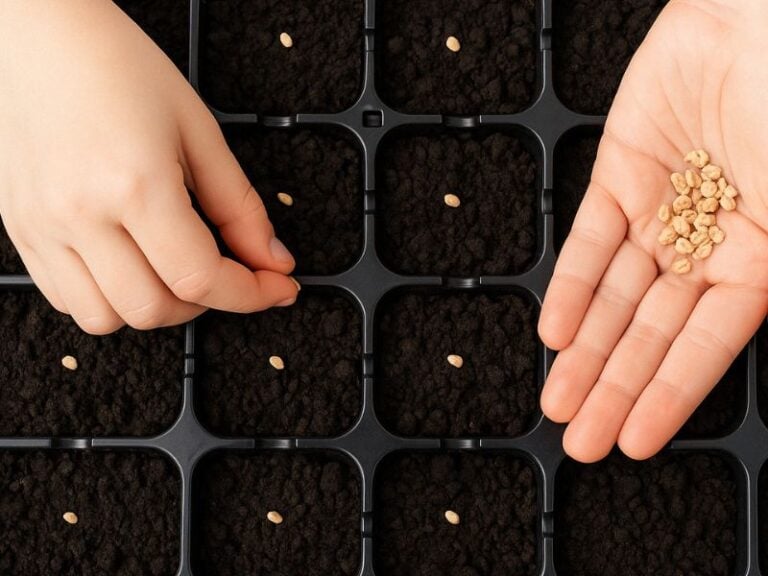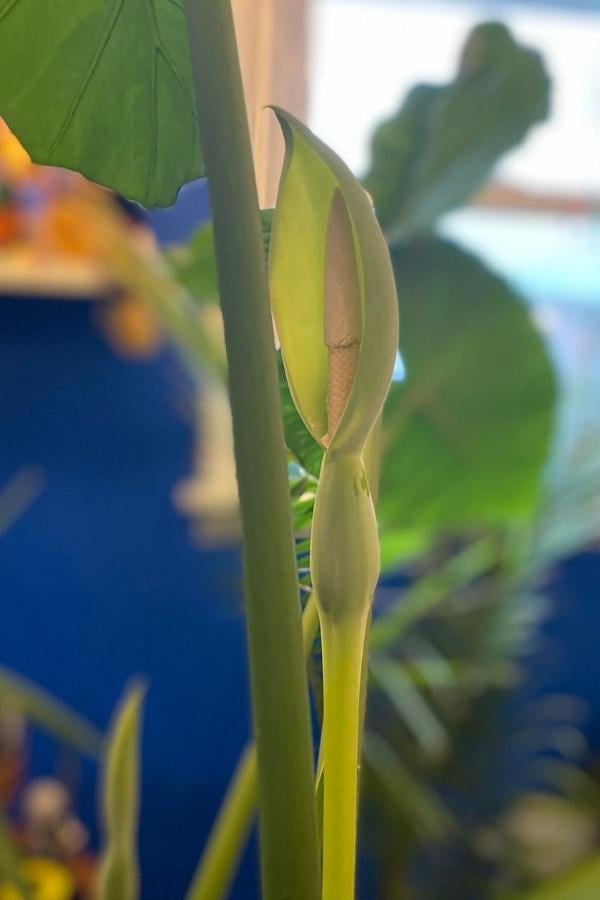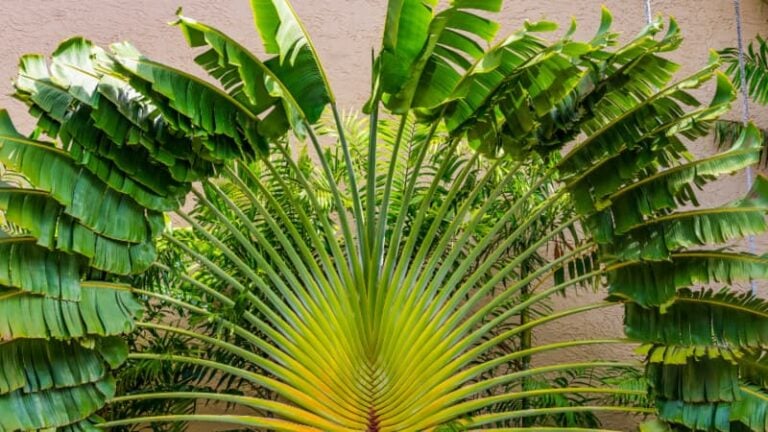The main limiting factor when growing vegetables indoors has always been the lack of light. Watering? Simply water well when the potting mix is dry. Air too dry? Run a humidifier. Fertilization? Follow the instructions on the package. But a windowsill in fall or winter, even if it faces south, just isn’t enough.
Due to short and often cloudy days, the light you get there is equivalent to deep shade. And vegetables and herbs need full sun. Don’t worry, though—it’s entirely possible to compensate with artificial lighting, and it’s actually easier than you think!
Contents
Basic Lighting System for Growing Vegetables Indoors
The simplest approach is to use a hanging linear lamp supported by chains from the ceiling or a shelf, since you’ll need to adjust the height of the lighting regularly.
It can be a fluorescent or LED lamp with two tubes, each about about 24 inches long, which will illuminate a growing area roughly about 24 inches by 24 inches.
That’s enough space for a small indoor vegetable garden. Opt for white light because it helps you see your plants’ condition more clearly. Lamps that produce a pinkish hue hide important growth details without giving you better vegetables.
Add an inexpensive timer to this lamp and set it to run for 14 to 16 hours a day. Next, fill pots or trays with moist potting mix and sow your seeds.
Place the lamp about 6 to 12 inches above the pots, and as the plants grow, raise the lamp so it always remains that 6 to 12 inches above the leaves at all times. It’s that simple!
Most people find that a single hanging lamp over their mini-garden delivers excellent results with minimal effort and doesn’t cost much. Go ahead, give it a try!
Which Vegetables Can You Grow Indoors?
Make life easier on yourself and stick to fast-growing vegetables and herbs, such as leafy greens (lettuce, spinach, arugula, etc.) and maybe small radishes. Also consider young-harvest herbs: basil, cilantro, dill, etc.
Along with microgreens, these are the best choices for indoors! Growing fruiting vegetables (tomatoes, peppers, etc.) is possible, but it requires extra intense, high-quality lighting. In that case, you’ll have to opt for a more sophisticated lighting system.
More Advanced Lighting Systems for Growing Vegetables
There are more sophisticated (and of course, more expensive) lighting systems available. If you really want to grow tomatoes and peppers indoors as if they were outdoors, you could convert an entire room into a grow space with 400- to 1000-watt grow lamps installed in the ceiling.
However, this setup will require adding an extra electrical panel, installing an air conditioning system, and using a CO2 generator. Plus, you’ll end up with a hefty electricity bill!
There are also automated systems, like AeroGarden units, that control lighting, watering, and humidity.
Types of Lighting for Plants
To provide partial or full artificial lighting for indoor vegetables, you can use several types of lighting equipment:
- HPS (High-Pressure Sodium)
- Fluorescent
- HQI (Metallic Vapor)
- LEDs (Light Emitting Diodes)
HPS (High-Pressure Sodium)
HPS lamps provide light in the spectrum of about 540 to 700 nm, typically in yellow, orange, and red tones. They’re suitable for producing compact, large flowers and are widely used by growers.
However, due to their relatively low level of blue-spectrum light, you can use them for seed germination and to increase flowering and fruit set in plants.
In practice, you can grow vegetables under HPS lamps throughout the year. Under this type of light, though, vegetables tend to grow taller with more space between leaves. Some indoor gardeners add compact fluorescent lamps alongside HPS to supplement light during the vegetative phase.
Keep in mind that this type of lamp consumes a lot of electricity and can run quite warm. However, HPS lamps come in different sizes, including small 150W models. A 150W lamp uses roughly the same amount of electricity as a 40-inch TV, so it won’t dramatically impact your electricity bill.
Fluorescent
Fluorescent lamps are available in various forms. They’re more efficient than incandescent lamps (producing more light for less electricity), but they generally provide a limited light spectrum (often in the blue/cool range), which isn’t ideal for stimulating plant flowering.
CFLs (Compact Fluorescent Lamps) are another popular form of fluorescent lighting. They’re also more efficient than incandescent lamps, use less energy, and last longer.
HQI (Metallic Vapor)
Like HPS, HQI lamps are high-intensity and can serve as an excellent light source for your indoor vegetables. They emit a blue-toned light, ideal for the vegetative phase, with a high number of lumens per watt and strong light penetration.
HQI lamps are more efficient than fluorescent lamps. For example, 1 watt of HQI power produces more light than 1 watt of fluorescent lighting.
In terms of the Color Rendering Index (CRI, which indicates how closely the lamp’s color matches natural sunlight), a 5200K HQI lamp reaches about 93%, while a 5250K fluorescent lamp tops out around 78%.
LEDs (Light Emitting Diodes)
LED lamps are relatively new in the indoor gardening world but are becoming increasingly popular. They’re energy-efficient and can offer the full light spectrum that indoor vegetables need throughout their life cycle.
LEDs run much cooler, and some models include built-in ventilation systems. They’re also easy to use—simply plug them in and hang them above your plants. LEDs provide strong light penetration, so you don’t have to move them frequently or place them on the sides of your growing area.
Now that you know more about the types of cultivation lights on the market, you can confidently choose the one that best suits your needs.
Advantages and Disadvantages
High-intensity lamps generate a large number of lumens per watt, making them extremely effective for leaf and flower/fruit growth. However, they also produce high heat levels, so you’ll need an efficient ventilation system with exhaust fans, ducts, and air vents.
Although HQI runs warmer than HPS, you should still keep HQI lamps at a safe distance from the plants to avoid contact and stress. Remember not to touch the bulbs and to be aware of their lifespan, which is much longer than that of fluorescent lamps.
Vegetables with LED or HPS?
You can choose between sodium vapor lamps (HPS) or LED lamps. LEDs are generally the better choice thanks to their energy efficiency and luminous efficacy.
Space Efficiency
You don’t need to worry too much about space with LED lamps, as you can keep them closer to the plants without burning them. HPS lamps, on the other hand, must be placed farther away to prevent heat damage. LEDs also last much longer than sodium vapor lamps.
Lifetime
You need to replace HPS lamps every six months on average (approximately 2,500 hours). In contrast, LED lamps can last well over 50,000 hours—an average operating time of 5-10 years—far exceeding HPS lamp longevity.
Light Spectrum
LED technology offers significant advantages by providing light spectra better suited to plants. This promotes greater growth and development of your vegetables, accurately simulating the natural light spectrum and supporting efficient photosynthesis. With multiple spectral bands, LEDs outperform single-spectrum lamps.
Energy Use Efficiency
LEDs generate light far more efficiently than traditional lamps. With about 60-90 lumens per watt, they surpass HPS lamps. At equal input power, LED lamps produce 5-6 times more light than standard HPS lamps. This can save up to 85% on electricity costs, greatly reducing your electric bill and environmental impact.
Moreover, LED lamps don’t require toxic substances like sodium, lead, or mercury, making them more environmentally friendly, especially regarding recycling.
Overall, LEDs are impressive both functionally (for growing and nurturing plants) and economically, while also protecting the environment and improving yields.
The Right Intensity
Grow light intensity depends on bulb power and the distance between the plant and the light source. Each vegetable differs in its need for certain light colors and intensities.
Generally, vegetables from tropical climates don’t require as much light as those from dry, sunny environments. Most flowering vegetables, such as tomatoes, prefer to be about about 10 to 12 inches from the light source.
For leafy vegetables like spinach, aim for around about 35 inches away from artificial light sources. Many flowering vegetables require higher light intensity to bloom and produce fruit.
If your home doesn’t have access to natural sunlight, don’t be discouraged! Artificial grow lights make it possible to grow vegetables indoors year-round. I’m curious—what type of grow lights are you using to grow vegetables indoors?


